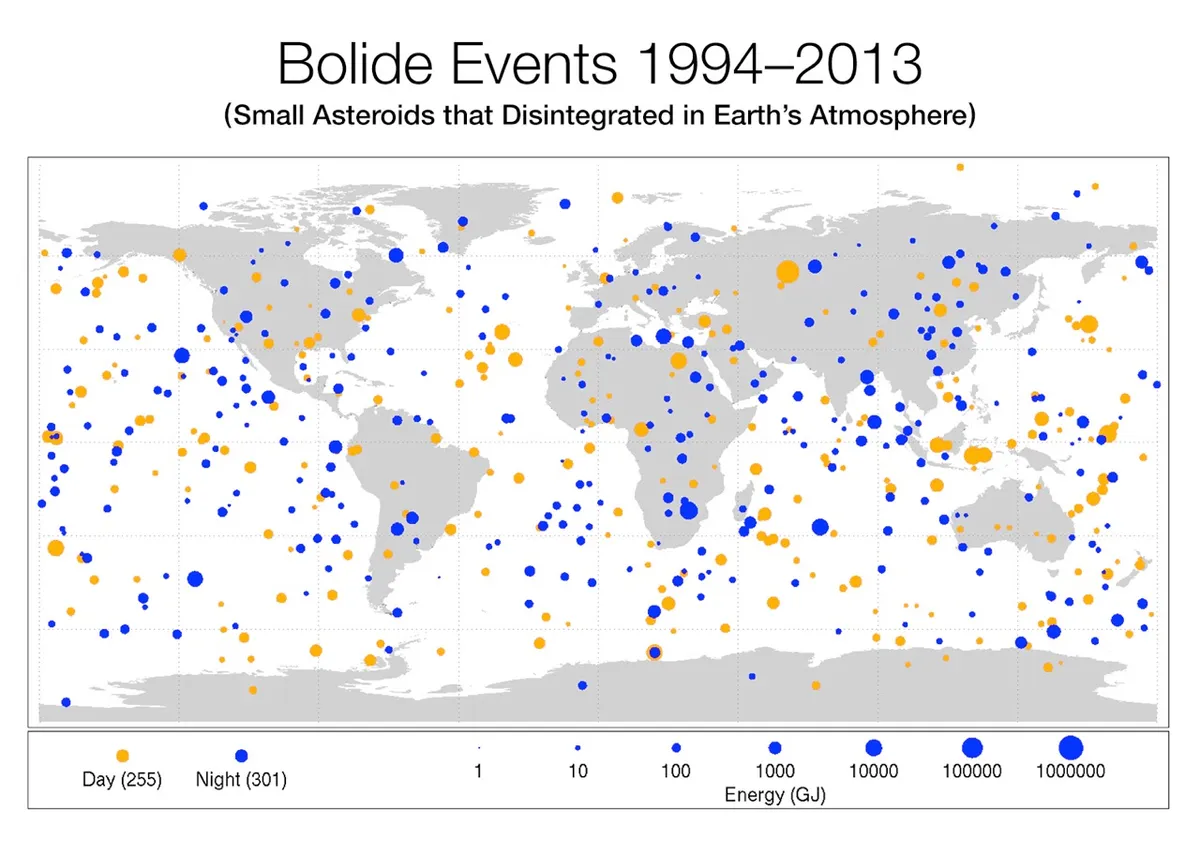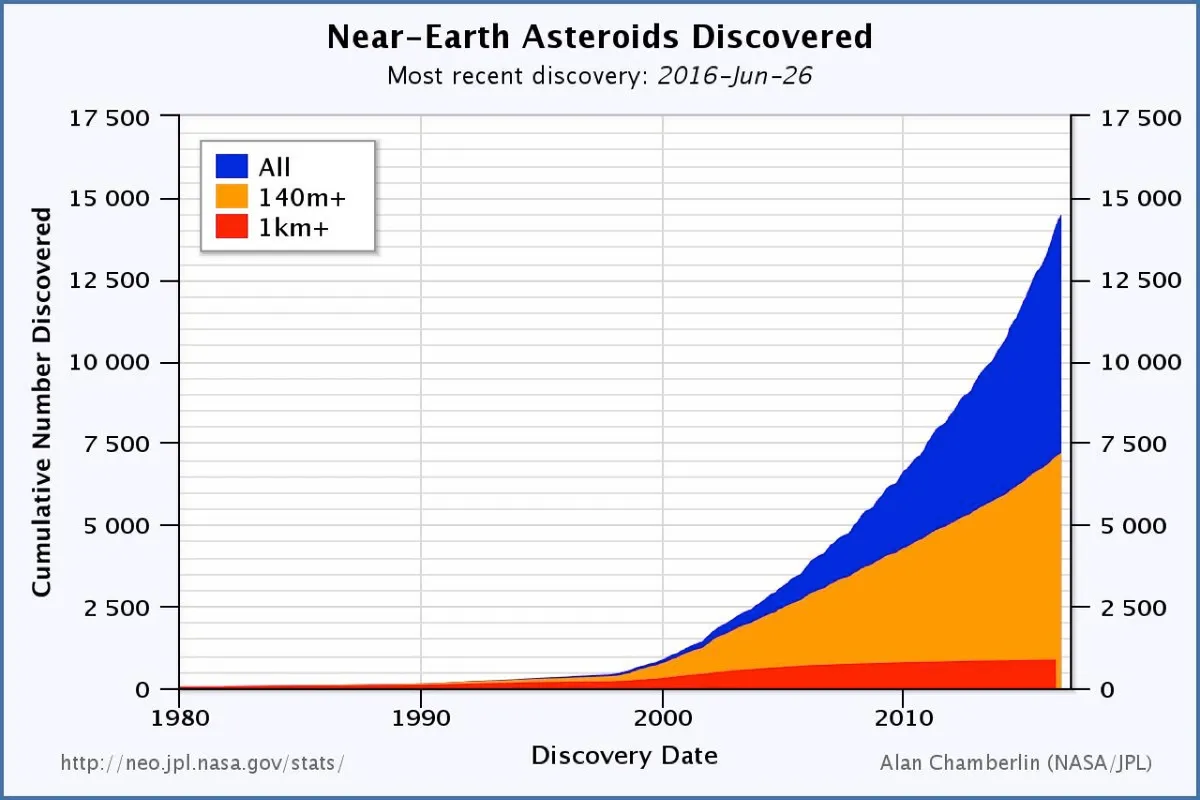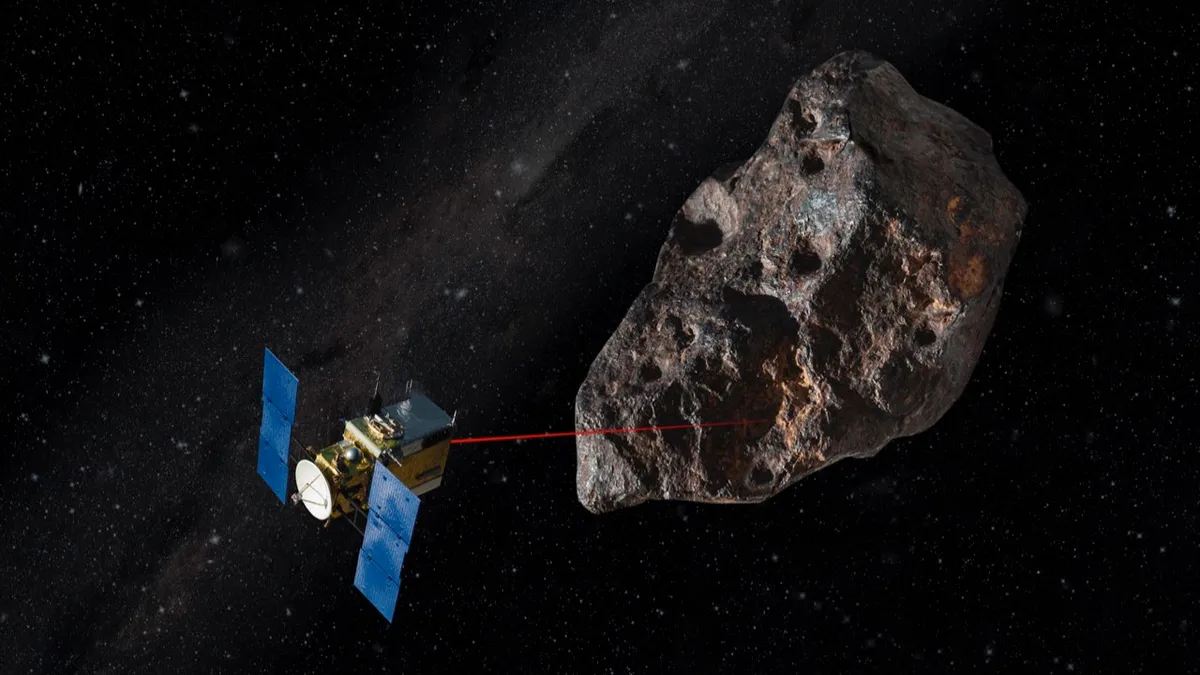Humanity was nearly wiped out in 1983, and almost no one noticed. Comet Iras-Iraki-Alcock was very dark, and very large, and very narrowly missed the Earth. Nothing has come as close in the past 200 years, and the pyramids were still being built the last time it zipped by. “An impact would have sterilised the planet,” says Bill Napier, author and professor of astrobiology at the University of Buckingham. Looks like we were lucky this time.
Impacts from comets and asteroids aren’t exactly the first priority on everyone’s mind when it comes to planning for the future. After all, what is the chance of an asteroid hitting Earth? Isn’t that just something from geology textbooks and ‘90s science fiction movies? “It happens more often than you would think, just that we don’t necessarily know about them,” says Clemens Rumpf, a researcher at the University of Southampton specializing in tracking and managing asteroids.
Following an international nuclear test ban treaty in 1963, American, British, and Soviet governments set up a network of infrasound microphones to monitor any explosions in the atmosphere. It’s still in operation today, and although the devices never picked up an explosion from a nuclear bomb (thankfully), what it does detect is about twoexplosions per year with energy signatures equivalent to at least the Hiroshima bomb. These are all meteoroids breaking apart in the upper atmosphere. Most explode over the ocean away from populated areas, but when they do happen over land, we tend to take notice.

Perhaps the most notable example of this was in 2013 when an asteroid exploded in the atmosphere near the city of Chelyabinsk in Russia. No one was killed but some 1,500 people were injured and over 7,000 buildings were damaged from the mid-air shock wave. Imagine what could have happened if it actually hit the ground.
Further back in 1908, another object – probably a comet – struck near the Tunguska River in Russia (again). Although the exact size of the object is unknown, and there are no recorded casualties, it is considered the largest impact event in recorded history. “An area equivalent to the greater London metropolitan area got completely flattened,” says Rumpf. “The forest trees just cracked down and were burned by the thermal radiation.”
Detection
We didn’t see these any of these objects coming. They were a complete surprise. “The fact of the matter is that we only know about 1% of the asteroids that could be dangerous to us,” says Rumpf. The main danger comes from the other 99% which we know are out there, but don’t know where. Most of these will be smaller objects that are harder to spot – and the smaller they are, the more numerous they get.
Fortunately, astronomers have been able to determine exactly where 90-95% of the biggest ones are – those planet-killers, a kilometre wide and more. This makes sense: the bigger something is, the easier it is to find. By calculating their trajectories, we can also tell that they won’t impact Earth within at least the next 100 years. “This is good news because those impacts would be really bad,” Rumpf comments dryly, “as for example the dinosaurs.”
“The harder we look the more we actually discover,” says Rumpf. You’d think this would be a call to arms to deepen the search and find as much as we can, as fast as we can. Instead, the issue is often sidelined. NASA currently has the imperative to find all objects larger than 140 metres by 2020, but it is already clear that they won’t reach that goal; they didn’t get enough funding to build the new telescopes required for the undertaking. In fact, the US Congress has consistently undercut funding for such planetary defence programmes.

“Even though we are beginning to tackle the problem – discovering more and more objects – the most likely scenario is still that they just hit [without warning],” Rumpf explains. “But as we discover more, the next likely scenario to happen is that we discover them and actually find out that there is no imminent impact.”
Despite Hollywood depictions of crowded asteroid fields, asteroids actually spend most of their existence floating peacefully through the void for aeons without hitting anything. “So it would make sense statistically that we actually discover the asteroid in its normal state where it just flies around, rather than in this very special circumstance where it’s just about to impact.” This means that when we eventually identify a credible threat, we’ll most likely have quite a lot of time to respond. “Fiveyears warning should leave a comfortable amount of mount a deflection mission,” says Rumpf.
Deflection
What would such a mission look like? Moving mountains as they free-fall through outer space seems like a Herculean task, but “achieving a change in position of the asteroid the distance of the diameter of the Earth is actually fairly easy,” Rumpf explains. Slowing it down by only a few millimeters per second would be enough to make a huge difference over the course of several million miles. “All we need to do is go to the asteroid and give it a little nudge.” Sounds simple enough. But how would we actually do that?
“We have a fairly good understanding of what we would do,” Rumpf says. “The response action would have to be tailored to the specific threat, so it’s dependent on the asteroid size, its composition, how much lead time we have.” Scientists have proposed several different options, somemore far-fetched than others (and each with their own difficulties), but all of them could actually work: We could slam it with a heavy metal projectile, knock it out of the way with nuclear blast, strap rockets or a solar sail to it, slowly break it apart with lasers, spray it with dark paint so that it heats up and vents gas in the opposite direction, or cruise alongside it with a big probe whose gravity would gently tug it off course.

In every case, however, the sooner we detect the threat, the farther away it will be, and thus the easier it will be to move out of the way. This is why developing better space telescopes to find more of the asteroid population is the current priority. After all, if we can’t spot them in the first place, there’s not much point in building the equipment to stop them.
Rumpf remains hopeful that with our technology we are well equipped to answer to the threat of an incoming asteroid. “That’s one of the great things about this type of natural disaster. To my knowledge it’s the only one that, if we know about it, we can completely prevent. I don’t think there’s any other natural disaster that we can do this. This is tremendous.” Perhaps he’s right to be optimistic.
However, Bill Napier’s research on giant comets from the outer solar system – called centaurs – paints a slightly less-encouraging picture. The greatest threat posed by these astral bodies isn’t necessarily from a (preventable) direct impact, but from the trail of dust and particles that would form as they move into the inner solar system. If Earth were to pass through this trail, it would engulf the upper atmosphere and create nuclear-winter-like conditions. Napier suggests that such a scenario could even have been responsible for several periods of global cooling and subsequent extinction events in the geological past.
There are currently no preventative measures to avoid this sort of catastrophe. “But the good news,” according to Napier, “is that a [comet] easing itself into an Earth-crossing orbit would be visible for centuries or millennia.” Hopefully that will give us enough time to come up with a contingency plan. Perhaps installing a comically large air filter in Earth orbit, or moving to a better neighbourhood. Mars suddenly doesn’t look so bad.
Nothing to lose sleep over
It’s easy to feel a sense of creeping dread when contemplating this gravitational game of cosmic snooker and resign ourselves to the maxim ‘ignorance is bliss’. Where are we to prioritise all this against a backdrop of recycling, saving for retirement, or buying car insurance?
Napier doesn’t lie awake at night in a cold sweat of existential panic. “It’s not something that concerns me,” he says. “I wouldn’t expect people to pay any attention to the hazard.” Rumpf agrees: “Personally I’m not concerned about it.” This is interesting coming from two people who have devoted their lives to the study of finding and preventing just such a hazard. “Maybe it’s because I’m mostly an optimistic person,” Rumpf adds. He also points out that just because we know more about these scenarios doesn’t make them happen more often. “You can just look in the last 100 years and judge for yourself how likely is it for something like this to happen – not very likely. So no it’s nothing too immediate to worry about.”
On the other hand, just because it doesn’t happen often doesn’t mean that it can’t also have very devastating – and very real – consequences when it does. As Rumpf puts it: “For a high risk to occur you can have one of two things – you can have an event that occurs very often and has medium impact on you, or you can have an event that occurs very rarely but, if it happens, it has a very high impact on you.” A direct impact from a large comet or asteroid falls in the latter category.
“Given this prospect that we have such good odds on our side – it’s super preventable, we can do something about it – I think it’s a very valuable place to put some resources in. Putting a little investment today can pay off huge dividends in the future. That’s kind of the underlying scheme.” This is ultimately the same rationale behind saving money in a retirement fund or getting life insurance, only on a planetary scale.
Fighting the good fight
What about threats we know are going to happen soon, if they aren’t happening already? Risks to national security, climate change, political turmoil. Why worry about some far off, far-fetched hazard from the skies? Is it even a responsible use of government money and resources, when just a few pounds could save the life of a child who is starving to death here on Earth, right this minute?
It’s hard enough to motivate people to do something about an issue like climate change – a much more pressing concern in terms of both likelihood and timescale. “To contrast it to climate science in one way is fair because it’s planning for the eventuality to have something in the drawer when we need it,” says Rumpf. “But the difference is that I think climate change is perceived as abstract by most people and in this case it will be very specific. We will be able to say ‘at that time this is going to happen if we don’t do anything about it’… So I think that we have an easier job than climate scientists to make a case for this.”
“Intelligent machines that make us look like chimps…” like HAL 9000 from 2001: A Space Odyssey
Napier is more concerned with the ground beneath than the heavens above. “I think a whole swathe of human-induced risks is of more concern to me individually,” he says. “Slide into nuclear war, some lunatic death cult creating a synthetic unstoppable virus, the growth of intelligent machines that make us look like chimps, global warming hitting a tipping point and the like.” It’s only when we start to look at history through a long-angle lens – on timescales significant to civilisation as a whole, and over the course of biological evolution – that “the giant comet scenario” begins to cast its shadow over other concerns.
In that respect, we, as individuals, shouldn’t be worried. We have plenty enough on our plate as it is. But that doesn’t mean that we can’t also prepare for the future as a species. “That is where I get my motivation for the work that I do,” says Rumpf. “It’s because I want to contribute to mankind’s ability to answer to this threat whenever it comes up because it can be really, really dangerous… It might not come up in my lifetime, but if it comes up then we should have the tools in place to send a spacecraft and push it out of the way.”
We here at Science Focusare glad there are people like Napier and Rumpf keeping their eyes to the sky – if not for us, then for or whoever inherits the planet after us.
Follow Science Focus onTwitter,Facebook, Instagramand Flipboard